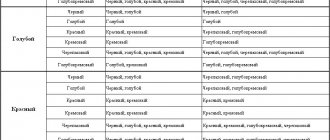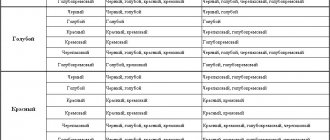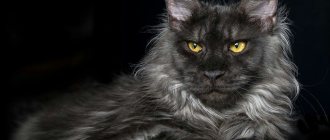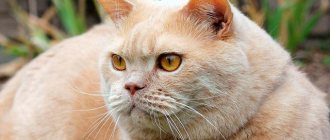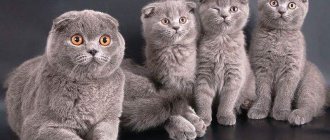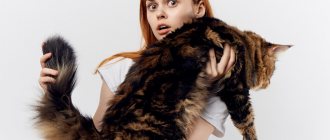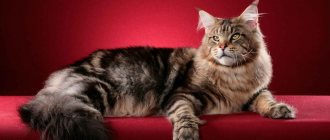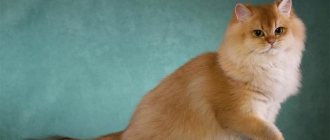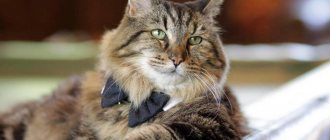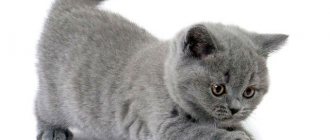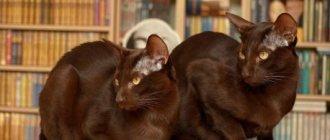The appearance of these domestic animals is closely related to the natural conditions of cold North America. In the article we will get acquainted with the colors of Maine Coons and take a detailed look at colors such as smoke, solid, tortoiseshell, white, red, marble and many others. No person who cares about animals can resist the beauty of these pets.
In our article about the description of the Maine Coon breed, we have already touched on the colors of these cats, today we will look at them in more detail.
Raccoon cat color classes
The color of Maine Coons is distinguished depending on:
- coat color;
- the presence of patterns or their absence;
- the presence of various spots or their absence.
In order to make it easier to distinguish the appearance of a cat of different breeds, taking into account the color of its coat, as well as a number of other characteristics, about 20 years ago the fife Assembly created the first EMS code system. This system was gradually improved, and now it is considered traditional for judging cats in all felinological systems.
Maine Coons are designated by the first letters of the Latin name of the breed – MC (Maine Coon). Since their hair is considered semi-long, coons were included in the II category of purebred cats, and designated with the letters SLH - from the Latin language Semi Long Hair.
Regarding the fur of all mustachioed pets, felinological systems agreed that male cats can only be of two colors - red and black. Other colors are the result of lightening or oxidation of these primary colors. White wool is considered to be a lack of color. Felinologists have noticed that Maine Coon kittens born with a white coat have one or more dark spots on their heads, which subsequently disappear.
The designations used in EMS coding are the first letters of colors or even color genetics in various languages, mainly English and French. White shades and spots on Maine Coon fur, as well as various patterns, are usually designated with a special number.
Maine Coon color chart with codes
| Color code | Color |
| a | blue |
| b | brown, chestnut, chocolate, Havana |
| c | lilac, platinum, lavender |
| d | red |
| e | cream |
| f | tortoiseshell |
| g | creamy blue, tortoiseshell blue |
| h | brown tortoiseshell |
| j | lilac tortoiseshell |
| n | black, wild, sable |
| s | silver, smoke |
| w | white |
| 01 | van (white except for one or more spots on the head, tail or shoulder area) |
| 02 | harlequin (van with spots on the back) |
| 03 | bicolor, two colors |
| 04 | white markings |
| 09 | white spots 1-2 cm in size |
| 11 | shaded hair colors (1/4 part) |
| 12 | veiled hair colors (1/8 part) |
| 21 | stripes, agouti |
| 22 | marble color |
| 23 | brindle color |
| 24 | spotted color |
| 25 | ticked tabby |
So, for example, a Maine Coon with black smoke coloring will be designated as ns. Next, the number of the drawing will be added, if there is one.
Most often in Maine Coons you can find such combinations as n 22, ds 22, d 22, n 23.
Maine Coon d 22
Maine Coon n 22
Maine Coon ns 22
Maine Coon ds 22
Rare and expensive Mei Coon colors
If we consider rare and expensive colors in a broader sense, then we can say with certainty that such colors do not exist. The most expensive and rare color can be considered any color of an animal, which is included in the standards of both American and European systems. But a rather rare occurrence could be, for example, the birth of a kitten that is completely the same color, despite the fact that its parents have fur with some kind of pattern.
Color codes for cats.
Degree of white spotting
Tabby drawing
Point color type
Elementary rules of genetics of cat colors. Two long-haired parents cannot produce a short-haired kitten. Only the parents' colors determine the color of the kitten. The colors of other cats present in the pedigree do not have a direct effect on the color of the kitten. A cat kitten always gets its color from its mother. A cat kitten always receives a color that is a combination of the colors of the father and mother. To produce a genetically red or genetically cream female kitten in a litter, the father must be genetically red or genetically cream, and the mother must also have a red or cream color in her genotype. Dominant characteristics (dominant colors: white, silver, tabby, bicolor, etc.) cannot skip a generation. They cannot pass, for example, from grandfather to grandson, without manifesting themselves in the father. A dominant colored kitten (black, red, tortoiseshell, etc.) must have a dominant colored parent. Two parents of a recessive color (cream, blue, etc.) cannot produce a kitten of a dominant color (black, red, tortoiseshell, etc.) A white kitten must have a white parent. A kitten with a white undercoat (veiled, shaded, smoky) must have a parent with a white undercoat. A veiled/shaded kitten must have at least one parent who is either veiled/shaded or a tabby. A veiled/shaded parent can produce a smoky kitten, but a smoky parent cannot produce a veiled/shaded kitten.
GENETICS OF CAT COLOR
The entire rich palette of cat colors depends in general on two coloring substances - eumelanin and faumelanin. The first is responsible for the black color (and its derivatives - chocolate, blue, lilac, fawn, cinnamon, the second - for red (cream). The genes that are responsible for the appearance of red (O - orange) or black (o - not orange) are located on the X chromosome, that is, the inheritance of color is linked to sex. Cats have two X chromosomes and, accordingly, three color options: - OO - red - oo - black - Oo - tortoiseshell. Cats have one X chromosome and, depending on which gene she carries O or o, it will be red or black. Tortoiseshell color in cats appears only in the case of genetic mutations. Thus, the inheritance of traits whose genes are located on the X or Y chromosome is called sex-linked. Genes localized in X chromosome and not having alleles on the Y chromosome are inherited from mother to son, in particular, a red cat will not be born from a black cat, and vice versa, a red cat will not give birth to a black series cat.
The colors of cats are very diverse. Some cats are uniformly colored - these are the so-called solid colors or solids. Other cats have a pronounced pattern - in the form of stripes, circles. This pattern is called tabby. Tabby “opens” on the coat thanks to the dominant gene A - agouti. This gene colors each cat's hair with evenly alternating dark and light transverse stripes. In dark stripes, a larger amount of eumelanin pigment is concentrated, in light ones - less, and the pigment granules elongate, acquiring an ellipsoidal shape and are located sparsely along the length of the hair. But if a homozygous allele (aa) – non-agouti – appears in the genotype of an animal with a black color, the tabby pattern does not appear and the color turns out to be solid. This influence of some genes on other genes that are not allelic with them is called epistasis. That is, the allele (aa) has an epistatic effect on the tabby genes, it “covers” them, masks them, and prevents them from appearing. However, allele (aa) does not affect the O (orange) gene. Therefore, cats of red (cream) color always have an open tabby pattern. Thus, all cats are tabbies, but not all are agoutis. Confirmation that all cats have a tabby in their genotype is the residual “ghost” baby tabby in many kittens. This residual tabby in cats of solid colors goes away, the cat sheds, the coat changes and becomes evenly colored.
COLORS OF THE RED SERIES
SILVER AND GOLDEN COLOR GROUPS
In the silver group of cats, only the end of each hair is colored and the root part of the hair is practically bleached (silvered). On the genetic background of non-agouti, the aa guard hairs under the influence of the inhibitor gene I do not stain almost half the length, and the undercoat remains completely white. This color is called smoky. But smoky colors with poorly bleached, grayish undercoat are often found. In smokes, the white part of the hair is approximately 1/8. In silver tabbies, colors that develop under the influence of an inhibitor gene based on the A- genotype, the hairs in the pattern are colored almost to the base, while in the background guard coat only the tips remain colored. The extreme degree of activity of the inhibitor gene is shaded and shaded (chinchilla) colors. In the first, the tip is painted approximately 1/3-1/2 of the length, and in the second, only 1/8, without stripes. This distribution of color throughout the hair is called tipping. “Cameo” is added to the names of the colors of shaded and shaded cats of the red series. Thus, the genotype of Chinchilla, Shaded silver, Pewter (Shaded Silver with copper eyes) and Silver Tabby is ABDI-. The difference in colors is caused by sets of polygenes. Chinchillas are brown tabbies, modified under the influence of an inhibitor gene and over many generations selected for the shortest tipping and the most shaded tabby pattern. Smoky cats of the black series have the genotype: aaB-DI-. Red silvers have the DIO(O) genotype. Red smokes can be genetically either agouti or non-agouti. The main feature of the golden color is that from 1/2 (golden tabbies) to 2/3 (golden shaded) and 7/8 (chinchillas) parts of each guard and integumentary hair are colored in a light or bright apricot, warm tone. The shades of this tone in different parts of the cat’s body may vary, but do not turn into dull grayish tones. Often in golden tabbies and golden shadeds there are residual ticking stripes on the darkly colored part of the guard hairs, which blurs the tabby pattern or gives a sloppy appearance to the shaded color. Also often found are intermediate colors between golden and regular black tabbies: the guard hairs are colored gold and the undercoat is gray. Among the patterned golden cats, there is another variation of the golden color - the undercoat is golden, the background of the coat is well lightened, and the outer hairs in the pattern are darkened almost to the roots. There are no ticking stripes and the “gold” is an intense, almost copper color. The genotype of golden colors: ABD-ii, that is, the same as that of Black Tabbies, and the phenotypic difference appeared as a result of selective selection and the accumulation of certain polygenes in the genotype. There is a theory of bigenesis of gold and silver colors. That is, the genes responsible for the silver color (inhibitors of melanin, and its yellow modification - pheomelanin) act independently of the genes of the golden color - inhibitors of eumelanin, black pigment (the fact that the golden color gene is also a pigment inhibitor is indicated by the correlation of color with green - unpainted - eye color). Each of these genes must be represented by at least two alleles that are active in an agouti or nonaguchi background.
Tabby
Various stripes on the coat of cats are combined into one name - tabby. In addition, tabbies are identified by expressive rims on the animals’ faces, which very often form the letter “M”. This color is called wild because it resembles real wild cats that live in forest areas.
Maine Coons can have different coat colors and one of three basic tabby patterns:
- Classic (Mackerel tabby);
- Spotted tabby;
- Brindle (Mackerel tabby).
The ticked tabby pattern is also quite common, but unfortunately, it is not recognized for Maine Coon cats. All other tabby patterns can be of any color recognized by the systems.
Classic (marble)
The classic tabby pattern, or marbled as it is also called, consists of wide curls and various continuous lines on the animal’s body.
Maine Coon black marble on silver
Maine Coon black marble with white
Spotted
Spotted Tabby has intermittent stripes on the animal's fur that give the appearance of patterns of spots. The spot can be of any size and any degree of clarity.
Brindle (striped)
The brindle tabby is quite easily recognized due to the vertical stripes that run parallel. Maine Coons, which have brindle coat patterns, often resemble small tigers, which is not at all surprising, because domestic animals are genetically close to large predators.
Maine Coon brindle (Mackerel tabby)
Maine Coon classic (Mackerel tabby)
Maine Coon Spotted tabby
ticked
In this case, there are no spots or stripes. Ticked coloring can be recognized by the characteristic pattern on the cat's face and agouti throughout the body.
If you look closely at each hair of a cat with a ticked tabby, you can see two smoothly transitioning colors. This hair color is called agouti.
Ticked coloring may occur in Maine Coons, but such a pattern has not yet been officially approved as part of the breed standard. Black and gold ticked patterns are often found in Abyssinian cats.
Maine Coon colors names with photos
The main genetic color variants of the breed are the Maine Coon with black fur and the pet with red fur. The color characteristics include information about the color of the fur, the type of pattern and the presence or absence of inclusions of other shades.
Black
Black is a rare color for Maine Coons. The pet's coat should be evenly colored, the tone should be even, the second name of the representative is Maine Coon of black solid color. According to the breed standard, only a small pattern is allowed, which is especially noticeable in bright light on a kitten. A pet with such fur should not stay in the sun for a long time, the fur coat will fade and its color will acquire a brown tint. The animal's eye color is copper or bright orange. Maine Coon black marble represents a cat with streaks on a black background.
White
The purest snowy coat of this coon is not colored with pigment; its absence makes the hairs white. The shade is fixed in the grown pet; such kittens are born gray or white with slightly noticeable cream stripes. With age, the color of the fur changes. The eyes are yellow or, less commonly, blue. Among animals with this color there are cats with eyes of different colors, the name of the feature is heterochromia. The white Maine Coon with blue eyes has a predisposition to deafness.
Ginger
The red Maine Coon, the classic version of the breed, wears a bright red coat, the color makes the cat look like a lynx. It is believed that representatives of this color are smarter and more savvy than other pets. The pattern is clearly visible on the sunny-colored wool. The Red Marble Maine Coon comes in a rich orange tone. The red Maine is in demand among buyers and cat lovers.
Blue
In a blue Maine Coon, the color from the roots of the hair can be gray or white. The shade of the coat is light or rich. Stripes, spots and tan marks are allowed in kittens; with age they become invisible. The Blue Solid Maine Coon is considered to have a uniformly colored coat; the presence of silver inclusions is not allowed. The eye color of representatives of the color is emerald and green.
Grey
Among the types of gray color, there are two options: cold and warm marble. Color is considered an indicator of the presence of black genes in Maine Coons.
Ticked
The forehead, chest and limbs of a ticked Maine Coon may be painted with a residual mottled pattern: a faint mark in the shape of the letter “M” on the forehead, circles or barely noticeable spots on the neck. The rest of the pet's surface is evenly covered with striped hairs. This color option is not so common among coons. At the root the pigment is more saturated, at the end of the hair it smoothly turns into a light tone. There is no clear pattern on the fur.
Tabby
Maine Coon Tabby is a type of coat that is drawn and is supposed to have stripes on its coat. The eyes of a representative of this color are outlined with a clear line, there are stripes on the muzzle and a slightly noticeable o. At close range, you can see the alternation of dark and light hairs on the coat, called agouti. Tabby colors come in the following varieties:
- classical;
- spotted;
- brindle;
- ticked.
The color can be shown by any of the pet's fur colors allowed by the breed standard. The shade is based on the tones of the stripes and the tip of the animal's tail. A variation of the tabby is also the chinchilla variant: 1/8 of the coat is dyed.
Tricolor
The tri-colored Maine Coon is a tortoiseshell variety that consists of cream, red, and black. Due to genetic predisposition, only females are born tri-colored; cats with this color are born very rarely. Tricolor cats are not considered a separate breed; this species arose accidentally, spontaneously. There is no historical information about the appearance of the fur variety.
Smoky
The roots of the smoky maincoon's hair are perfectly white. This is the main difference between the species and the blue pet. Varieties of smoky suit:
- black smoke;
- blue smoke;
- tortoiseshell.
The color saturation of 50% of the hair on the surface of an animal's fur is called “normal” smoke. The coloring of ¼ of the fur coat of a purebred animal has a name: “shaded” smoke. The color and location of the pattern fills 1/8 of the hairs, which means it is a Maine Coon Chinchilla.
Tortoiseshell
Pets with a tortoiseshell color are divided into two varieties: black and red, as well as bluish-cream. Particles of the presented shades on a colored coat are evenly scattered over the surface of the animal’s fur. It is believed that this color of fur occurs in cats. A male representative with this coloring appears rarely and cannot have offspring, as he has a feature: infertility.
There are varieties of tortoiseshell color: scaly and patchwork, as well as tortoiseshell tabby. There are variants of black wool with this type: torbi (a mixture of red and dark brown) and torti (red and cream). The tortoiseshell species can be presented in addition to white spots with clear, pronounced outlines.
Silver
A color is called silver if there are patterns on the smoky coat with a white root. Carriers of the color have emerald-colored eyes. Pets of the merle color on silver have peach-colored stripes on a light surface.
Chocolate
The chocolate shade of the Maine Coon's coat is not included in the classification of the breed standard. The first individual of this color, nicknamed Brownie, got the shade by accident. There are assumptions: her ancestors were Siamese cats.
Cream
The cream Maine Coon is considered a variety of red color. The pet has a delicate light shade of coffee with milk; spots and stripes are acceptable on the fur coat. A pure solid tone does not occur.
Marble
The type of color has a contrasting pattern: a combination of the main color with clear stripes and shapes. The following characteristics are acceptable for a marbled Maine Coon:
- clear round and oval shapes with obvious boundaries;
- large parallel wide lines along the body;
- butterfly pattern between the shoulder blades;
- the letter "M" on the pet's forehead.
brindle
Brindle coloring suggests the presence of vertical lines on the surface of the coat. Variegated blurry spots on the sides of the limbs complement the main pattern.
Spotted
The coat of the spotted Maine Coon is covered with fuzzy circles; this type has spots of different shapes and sizes in the form of intermittent stripes. Types of white spotted color:
- bath; a spot on the head and about three on the body;
- harlequin; there are markings on the back, legs and partly on the tail;
- bicolor, ½ blonde hairs.
Forest (wild)
Forest color - black marbled type. In appearance, a pet with such a fur coat resembles a wild cat. It is probably because of this color that the idea arose about the origin of the Maine Coon from the lynx and jungle cats.
White marks
Many Maine Coon fans try to breed kittens with touching white spots. This is explained not only by the fact that the markings on raccoon cats look spectacular, but also by the fact that some felinologists consider the absence of white in the color to be a real defect.
White spots on the Maine Coon's coat can be located on any color and be of completely different sizes, but they are always clearly visible, unlike Siamese cats, whose spots are shaded and do not have clear boundaries.
Maine Coons color tuxedo
Maine Coon kitten, harlequin color
Maine Coon with white socks
Maine Coon black and white To scientifically describe the color with a white spot, simply add “with white” to the main coat color, for example, black and white or red and white. People often call this color of a cat simply black and white or white with spots.
Color classification of Maine Coon with white spots
| Russian color name | English color name | Color characteristics |
| White gloves | mitted | the presence of white “slippers” on the paws |
| White medallion | locket | the presence of a white mark on the chest, which may resemble a tie, bow tie or even a collar |
| White buttons | buttons | the presence of one or more small spots that have a clear outline |
| Bicolor | bi-color | Maine Coon's coat is exactly half white |
| Harlequin | harlequin | the coat is completely white, except for a few large colored spots |
| Wang | van | the coat is completely white except for the head and tail |
| The tuxedo | tuxedo | a gentleman's set of a beautiful combination of white gloves and a white medallion on colored wool (this definition has not yet been officially recognized) |
Smoky colors
The smoky color is considered a solid variety of silver tabby. The color is also called smoky if each coat of a Maine Coon is white at the base, but black or blue at the tip. Only a cat with distinctly white roots can be called smoky - gray roots are characteristic of monochromatic animals.
Maine Coon black smoke
Maine Coon peach smoke
Maine Coon blue smoke
Maine Coon smoke is divided into several types depending on the length of the colored hair:
- Chinchilla - the predominant color on the coat is white, only the tips of the hairs are colored.
- Shaded smoke - only a quarter of the tip of the hair is colored.
- True smoke - the wool is half colored.
- Black smoke – black coat color and white roots.
- Blue smoke – blue coat color and white roots.
- Silver – light coat with white roots. You can distinguish such a cat from a white one by its eyes - in a silver cat they are always green.
- Cream (cameo) - kittens with this color are mostly born white, the topping becomes noticeable only over time.
Maine Coon black shaded smoke
Maine Coon Chinchilla It is quite difficult to accurately determine the type of smoky color, but in any case, this coloring of the whiskers always produces an impressive effect, especially when the cat plays or moves gracefully, shimmering light smoky colors on its fur.
Color features
In fact, the smoky color is a slightly modified black. The main length of the hairs is painted in a dark shade, and only at the ends does it disappear.
From the point of view of cat genetics, white color is a complete absence of color, therefore, such a color indicates that there was not enough pigment to completely color the hair for some reason. These may be genetic characteristics, inherited specificity, or simply a deficiency in the body of the pigment responsible for the black color of the Maine Coon.
© shutterstock
There are two types of smoky color:
- False smoke color is characterized by a change in the intensity of the black shade closer to the root of the coat. That is, the tips are black, and the roots are rather grayish. In some cases they may have a blue tint. Sometimes this color looks really black, and only upon detailed study can you notice a change in shade at the roots.
- True smoke. A cat with black smoke color will definitely have completely white parts of the fur at the roots. In this case, the smoke is immediately visible: the fur is, as it were, illuminated from the inside, it shimmers, its shade changes on different parts of the body.
In true smoke Maine Coons, the white root of the hair turns the fur coat into a living one: any movement makes it live, play and shimmer.
Solid colors
The name “solid” was given to cats whose fur is completely the same color.
The monochromatic color is the result of the painstaking work of breeders, and it is quite difficult to find it. Often, upon careful examination of the cat, you will notice a subtle tabby pattern.
The Maine Coon is especially impressive because it is white in color with different or bright yellow eyes. Agree, the impressive size of the cat with white fur, which in addition makes him look fat, will not leave any fan of this breed indifferent.
The Maine Coon Solid black color is in no way inferior to white cats. Many lovers of this breed wait for many years to acquire such great happiness.
Maine Coon blue solid
Maine Coon black solid
Maine Coons white solid
Maine Coon red solid But completely red and red Maine Coons are acquired not only due to their bright appearance. Most animal psychologists, observing the behavior and intelligence of raccoon cats, have come to the conclusion that it is these pets that are the most intelligent among their fellows.
Character and behavior
Representatives of the Black Smoke Maine Coon breed are endowed with a kind, playful, affectionate character. They become strongly attached to their owner and require attention and care on his part. The main feature of pets is the ability to “talk”. Cats make sounds that are not like meowing, but can be compared to human conversation. Animals come to the place where the owner is resting and lie down next to him. They get along well with children, but are in no hurry to play with them.
Cats are independent, proud individuals. They will never touch the bowl of other animals in the house, will not take the owner's food from the table and will not beg. They love to have fun with toys, they quickly flirt, and the ball is especially interesting for them. Maine Coons Black Smoke do not tolerate parting well with their owner, even if he leaves for a short time, they are seen off at the door and always greeted.
If there is a need to go on a business trip, it is recommended to think through options with whom to leave a representative of the breed, otherwise he may get bored.
Tortoiseshell colors
The tortoiseshell color of the Maine Coon is associated with the history and origin of the breed. Since ancient times, these giant cats have had to adapt to survive in North America, where winters are often frosty and long. It was the tortoiseshell colors of the “fur coat” that served as a real salvation for cats, because with its help they could hide unnoticed in snowy thickets. The tortoiseshell color on the coat of Maine Coons remains quite popular to this day.
Unrecognized colors
Maine Coons of chocolate, gold, lilac, Siamese or any combination thereof are often not allowed to show.
There are also restrictions on the nature of coloring: colors and patterns that are found in Asian breeds are not recognized in raccoon cats. These include fawn, sorrel, cinnamon, point color, as well as any acromelanic colors. It is believed that oriental blood spoils the massive and powerful backbone of the Maine Coon. Ticked tabbies are also prohibited from showing.
Ticked Maine Coon
Maine Coon ticked color Breeders are diligently developing more and more new colors. Whether it's black markings on silver or blue markings next to white and tan spots, the famous wild colors will turn the Maine Coon into a real star of the show catwalk.
The Maine Coon breed truly delights with its variety of colors. Don't forget to help your pet properly care for its coat so that it always looks truly regal!

